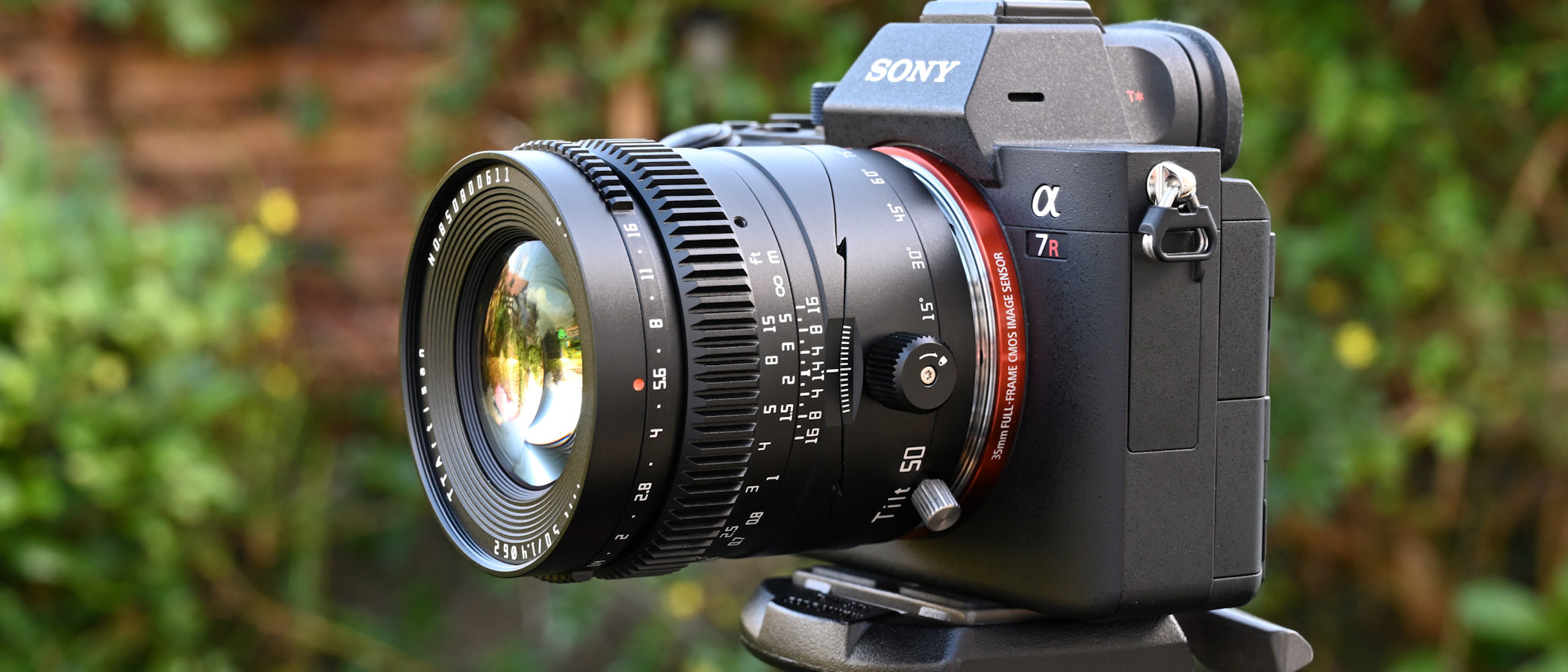Digital Camera World Verdict
There are times when blur is more important than outright sharpness. As a tilt lens, this TTArtisan can reduce the effective depth of field to a tiny amount, giving that classic ‘toy camera’ effect. At the other end of the scale it can give you a virtually infinite depth of field for keeping everything sharp from close foreground areas to the distant horizon, for objects that are in the tilted plane of focus. Sharpness itself is pretty mediocre and there’s noticeable color fringing and barrel distortion, but this fully manual lens is nevertheless enormously versatile. Considering that it only costs about a tenth of the price of up-market tilt & shift (or perspective control) lenses, it’s a good buy at the price.
Pros
- +
+/-8 degrees tilt
- +
0-90 degree rotation
- +
Fast f/1.4 aperture
Cons
- -
Tilt only, no shift
- -
Mediocre sharpness
- -
Fully manual, no electronics
Why you can trust Digital Camera World
As a ‘tilt’ lens, the TTArtisan Tilt 50mm F1.4 is designed so that you can literally tilt the axis of the optical path relative to the image sensor in the host camera. So what’s the big deal? In short, it gives you enormous control over the depth of field, irrespective of the focal length of the lens or the aperture setting.
On one hand, you can tilt the plane of focus in the same direction as the subject, to create a huge depth of field for keeping very close areas and a distant background simultaneously sharp, even when using a wide aperture. On the other, you can apply shift in the opposite direction to keep one small area in sharp, while throwing the rest of the scene out of focus to create a ‘toy camera’ effect.
Many top-notch ‘perspective control’ lenses offer both tilt and shift functions. The latter is useful for correcting perspective effects, for example keeping uprights parallel in architectural photography, so that buildings don’t appear to lean inwards towards the top. This TTArtisan lens is more of a single-function optic, with just a tilt facility, opposite to the way the Laowa FF S 20mm F4.0 C-Dreamer offers shift without tilt. It’s a full-frame compatible lens and is currently available in Sony E and Leica L mount options, the latter enabling native use with Panasonic and Sigma mirrorless cameras.
Specifications
Mount: Sony E, Leica L, Nikon Z, Canon RF, Fujifilm X, MFT
Full frame: No
Autofocus: No
Image stabilization: No
Lens construction: 7 elements in 6 groups
Angle of view: 45 degrees
Diaphragm blades: 12
Minimum aperture: f/16
Minimum focusing distance: 0.5m
Tilt angle: 8 degrees
Filter size: 62mm
Length: 70mm
Weight: 452g
Key features
There have been perspective control lenses in the past that have only enabled tilt and shift functions in one orientation, most notably from Nikon. Although the TTArtisans only offers a tilt function, it features full 90-degree rotation so that you can apply tilt in both horizontal and vertical directions. The maximum tilt angle of 8 degrees is par for the course and ensures wide-ranging control over depth of field.
Naturally, if you set the amount of tilt to zero degrees, the lens operates as a standard 50mm f/1.4 prime, making it useful for regular shooting, especially when you want a bright aperture to enable fast shutter speeds under dull lighting for freezing motion.
Even so, ‘regular’ shooting is a little hamstrung by the lens being a fully manual optic. In the absence of any built-in electronics to communicate with the host camera body, you need to set the aperture manually, as well as focusing manually, using the lens’s onboard control rings. That’s not as much of a pain as it might sound, as mirrorless cameras typically offer a ‘focus peaking’ display to help with accurate manual focusing, and enable a bright viewfinder image even at narrow apertures.
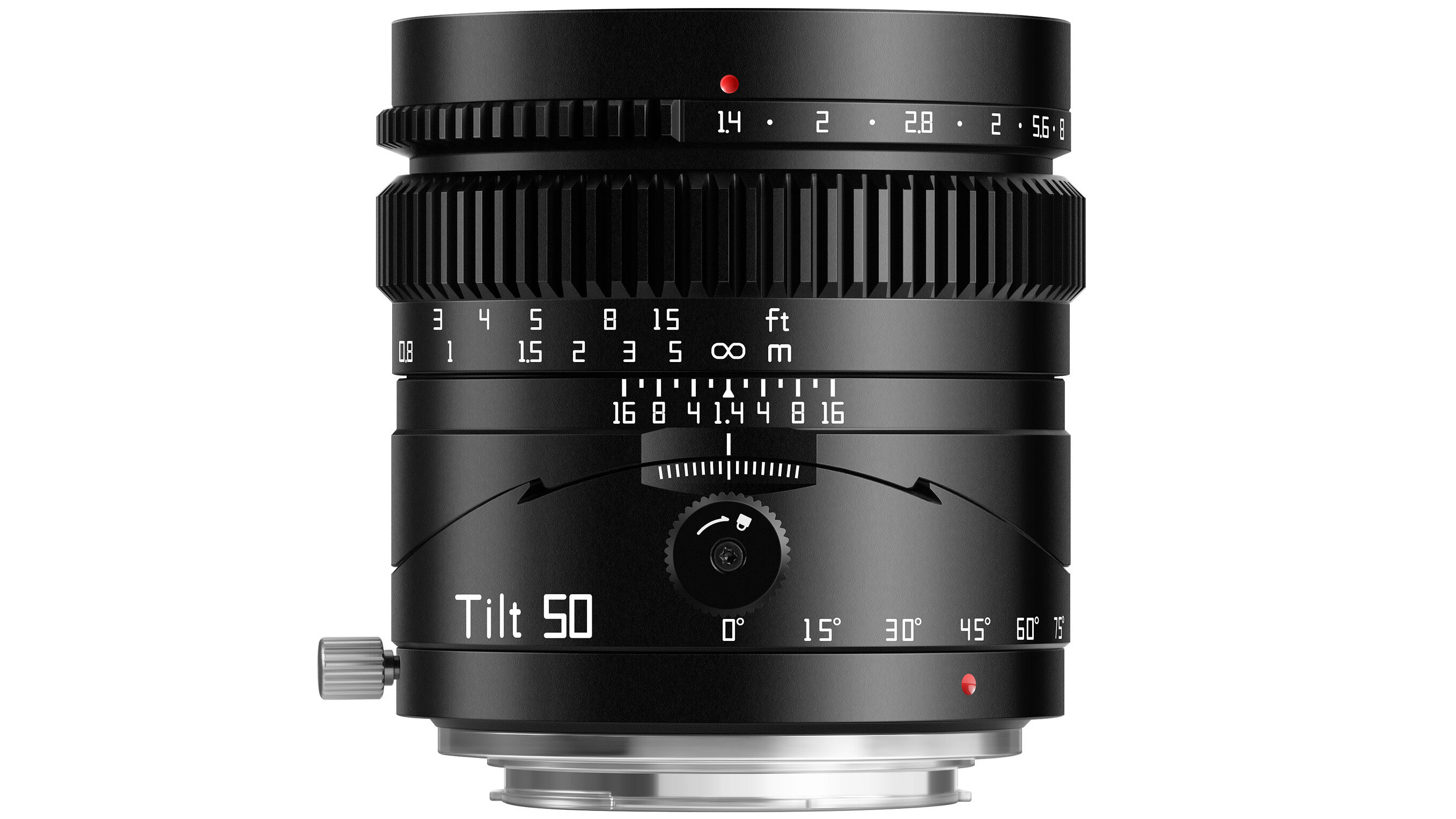
The optical path incorporates seven elements in six groups and includes two high refractive index elements, which help to enable a fairly compact, lightweight construction. The aperture diaphragm is particularly well-rounded, based on 12 blades.
Build and handling
Just as with dual-function tilt & shift lenses, a single-function tilt or shift lens needs to produce a significantly oversized image circle. This enables you to tilt or shift out towards the circumference of the image circle while still being able to cover the entire surface of the image sensor. And in this case, that’s a full-frame image sensor. Taking that into consideration, the TTArtisan is quite compact and lightweight, measuring 70mm in length with a 62mm filter attachment thread, and weighting in at 452g.
The focus and aperture rings operate quite smoothly and precisely. The aperture ring is de-clicked, which is ideal for shooting video, less so for stills. Another bonus for video capture is that both of the focus and aperture control rings are ridged for compatibility with most focus followers.
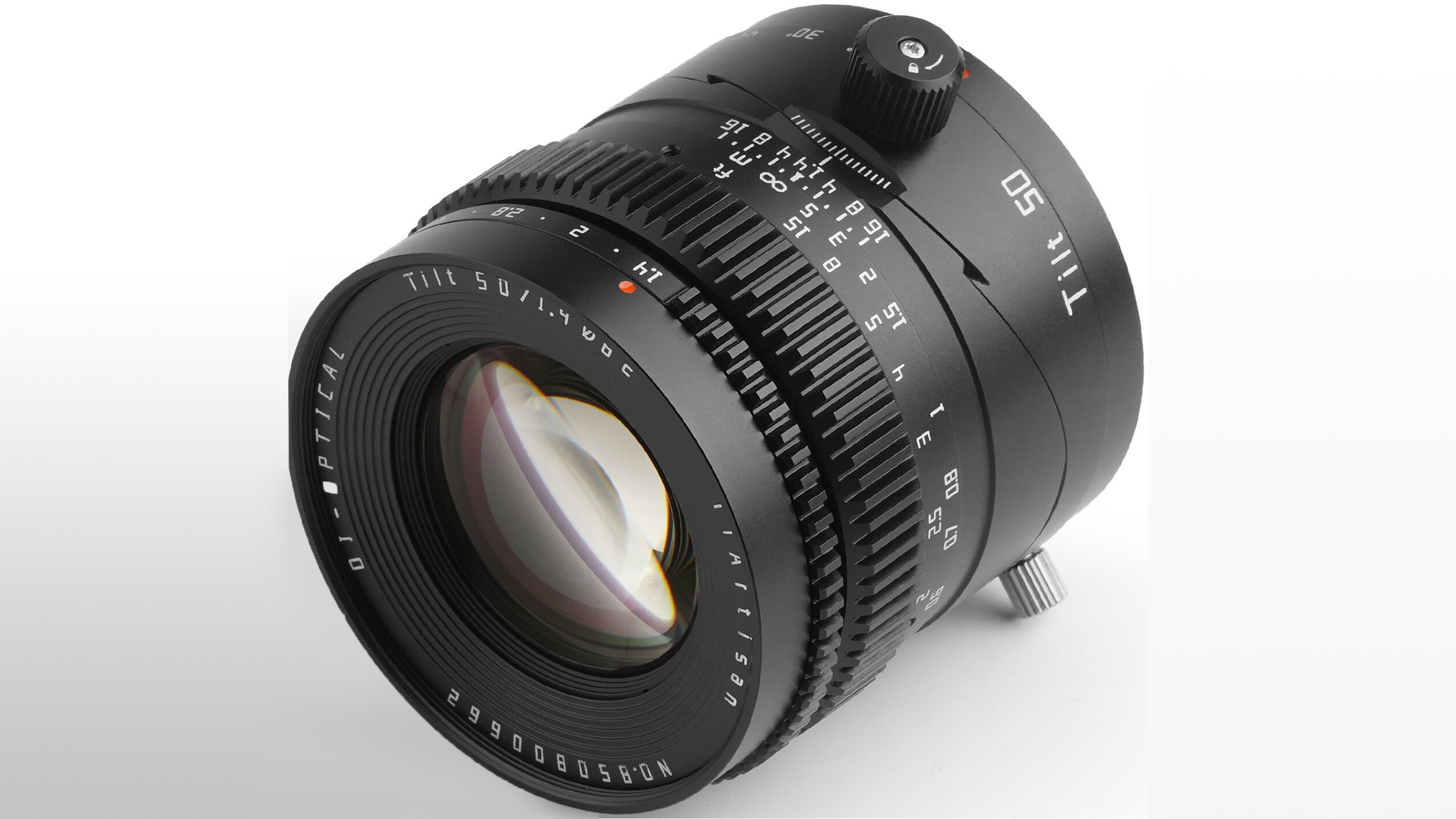
As well as having clearly marked focus distance and aperture scales, the lens features a depth of field scale. Naturally, that becomes meaningless when you start applying tilt. The tilt function itself has a locking screw to prevent accidental movement, and so does the rotation mechanism, both of which have scale markings on the lens barrel. The tilt mechanism has a click-stop at its center for a zero-tilt adjustment, and the rotation control has click steps at 25-degree intervals.
Build quality feels very good for a lens that’s so inexpensive to buy, but there are no weather-seals.
Performance
When looking at the performance of this lens, it’s worth putting things into perspective, so to speak. For a point of reference, the Canon TS-E 50mm f/2.8L Macro Tilt-Shift and Nikon PC-E Micro 45mm f/2.8D ED both cost a couple of grand or more, and the Laowa FF S 20mm F4.0 C-Dreamer is north of a grand. At around £197/$199 the TTArtisan Tilt 50mm costs a small fraction of the price. If you’re only interested in a tilt facility, it only costs around a tenth of the price of most tilt & shift lenses and the Laowa shift lens doesn’t offer a tilt function anyway. Another plus point is that the TTArtisan has a much brighter f/1.4 aperture than any of the other lenses.
In our tests, outright sharpness proved pretty lackluster even in standard trim with no tilt applied. At the center of the frame, levels of sharpness are about the same as the corner sharpness we’ve experienced from many recent mirrorless lenses. And it drops off further still at the edges of the frame with apertures of f/2.8 and wider. Stopping down to between f/4 and f/8, sharpness is actually better away from the center of the frame, which can play into your hands when using a large amount of tilt to minimize depth of field.
Color fringing is noticeable away from the central region of the frame and barrel distortion is quite pronounced for a 50mm prime. Automatic in-camera corrections are unavailable. Vignetting at the corners of either the left or right side of the frame is very pronounced when using more than 2-3 degrees of tilt to the right or left respectively with zero-degree rotation, requiring images to be slightly cropped.
Although sharpness isn’t particularly good, the lens bounces back with nice bokeh for defocused areas in images. That’s a major plus point when using the tilt function to minimize depth of field and create a toy camera effect.
There’s naturally no autofocus and the aperture also needs to be adjusted manually via the onboard control ring but, taking everything into consideration, performance is pretty good for such an inexpensive tilt lens.
Sample images



Lab results
We run a range of lab tests under controlled conditions, using the Imatest Master testing suite. Photos of test charts are taken across the range of apertures and zooms (where available), then analyzed for sharpness, distortion and chromatic aberrations.
We use Imatest SFR (spatial frequency response) charts and analysis software to plot lens resolution at the center of the image frame, corners and mid-point distances, across the range of aperture settings and, with zoom lenses, at four different focal lengths. The tests also measure distortion and color fringing (chromatic aberration).
Sharpness:
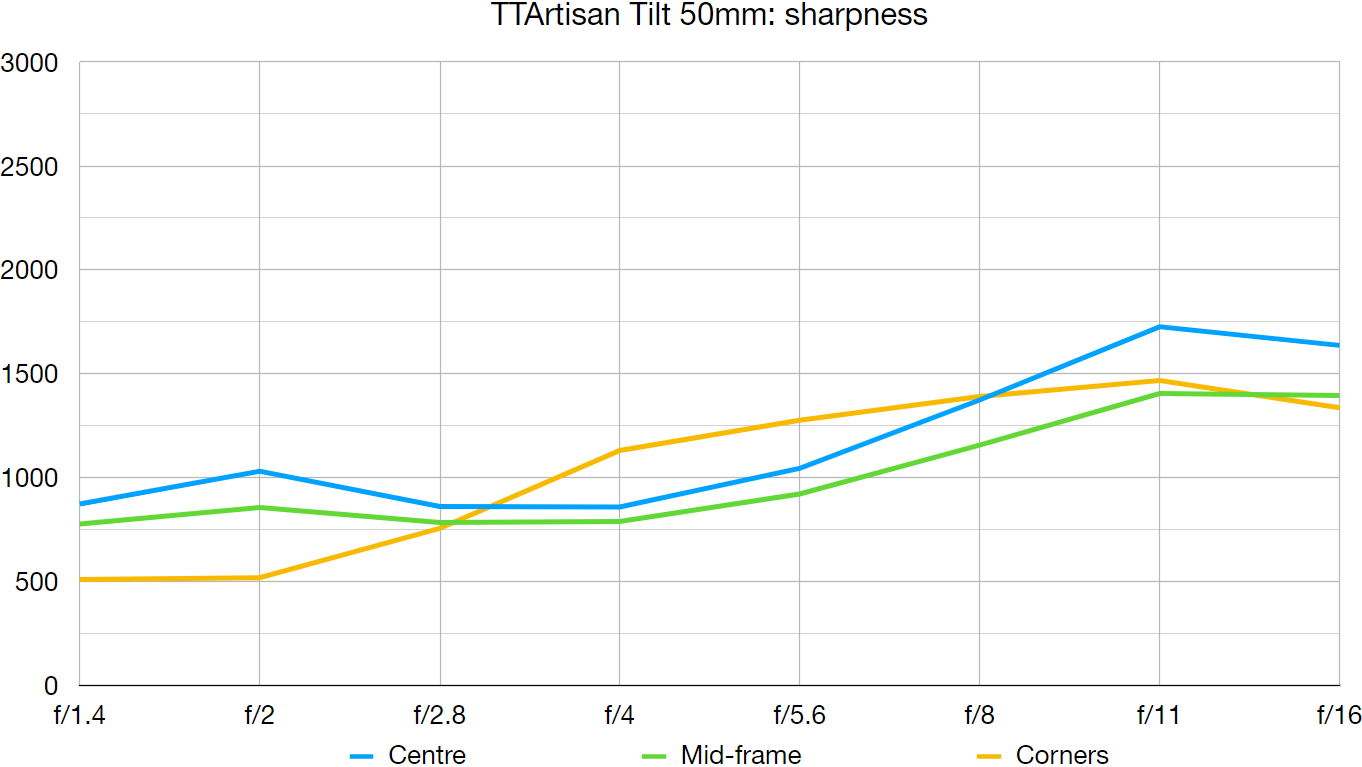
Our lab tests for sharpness were recorded without any tilt being applied. Overall sharpness is uninspiring at most apertures. It’s disappointing from f/1.4 to f/4, peaking at f/11 to f/16. The lens is actually sharper away from the central region of the frame at apertures between f/4 and f/8, which can improve performance when using a large tilt angle to minimize depth of field.
Fringing:
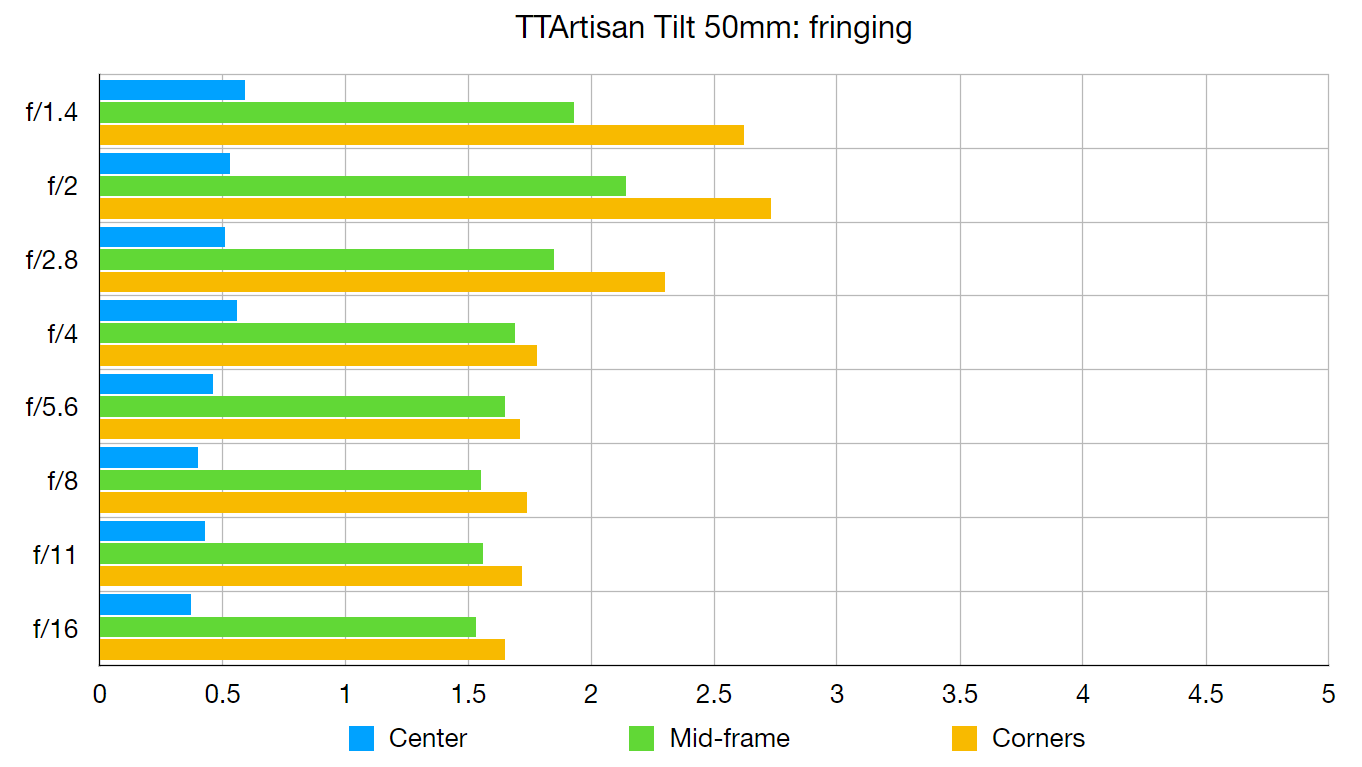
There’s very little color fringing in the central region of the image frame, throughout the entire aperture range. Away from the center, however, fringing can be noticeable at all apertures.
Distortion: -2.15
We’d expect very little distortion from a 50mm prime lens but the TTArtisan produces noticeable barrel distortion.
Verdict
There are times when blur is more important than outright sharpness. As a tilt lens, this TTArtisan can reduce the effective depth of field to a tiny amount, giving that classic ‘toy camera’ effect. At the other end of the scale it can give you a virtually infinite depth of field for keeping everything sharp from close foreground areas to the distant horizon, for objects that are in the tilted plane of focus. Sharpness itself is pretty mediocre and there’s noticeable color fringing and barrel distortion, but this fully manual lens is nevertheless enormously versatile. Considering that it only costs about a tenth of the price of up-market tilt & shift (or perspective control) lenses, it’s a good buy at the price.
Read more:
• Best camera lenses to get
• Best Canon lenses
• Best Nikon lenses
• Best Sony lenses
Matthew Richards is a photographer and journalist who has spent years using and reviewing all manner of photo gear. He is Digital Camera World's principal lens reviewer – and has tested more primes and zooms than most people have had hot dinners!
His expertise with equipment doesn’t end there, though. He is also an encyclopedia when it comes to all manner of cameras, camera holsters and bags, flashguns, tripods and heads, printers, papers and inks, and just about anything imaging-related.
In an earlier life he was a broadcast engineer at the BBC, as well as a former editor of PC Guide.
